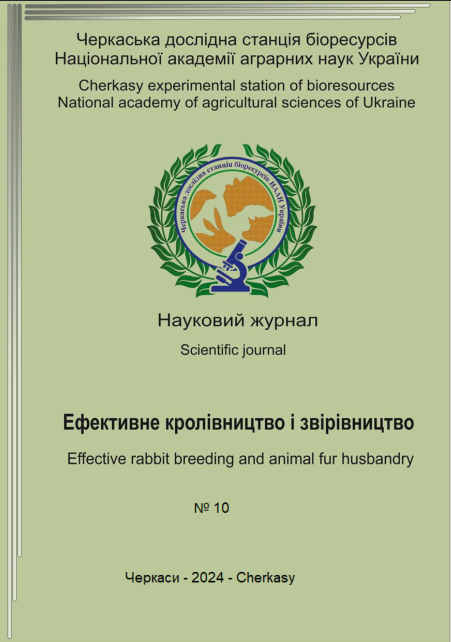VARIABILITY AND NATURE OF HERITABILITY OF BREEDING AND GENETIC PARAMETERS OF MINK MALES AND FEMALES PRODUCTIVITY IN A NUMBER OF GENERATIONS WHEN USING CROSSBREEDING
DOI:
https://doi.org/10.37617/2708-0617.2024.10.42-52Keywords:
american mink, genotype, crossbreeding, productivity, heritability, correlationAbstract
According to the results of retrospective analysis of electronic databases of productivity indicators of brown minks of Cherkasy regional consumer union (2008-2014, n = 17400 heads), the level of variability and the nature of heredity of breeding and genetic indicators of productivity of populations of domestic minks obtained by crossbreeding of Scandinavian minks with domestic mink of standard brown type were studied. It was established that during the study period, the improvement of breeding and genetic traits from the first to the fifth generation of animals was observed in the studied population of minks. The average value of the length of the mink of the initial generation was within 44.73 cm; the corresponding value for the body of the F4 offspring was 1.16 cm higher, and in the next generation we observed a sharp decrease in the value of this indicator by 2.0 cm. In the study of the quality of pubescence and color intensity of mink females in a number of generations, low variability of these traits was noted (C.V. = 0.63-1.50%). When studying the size of the white spot on the fur of mink females, it was found that this indicator in the animals of the studied population had a low level of variation and was in the range of 6.80-16.20 %, with extreme values of the trait score of 3 points. The minimum average value of the assessment of the size of a white spot on the fur - 4.18 points - was observed in the animals of the original generation. In the offspring, there was a tendency to improve the quality of fur for this trait with its maximum values in 2011 and 2014 - 4.90-4.82 points, respectively. Since 2011, the majority of females (68.6-90.0%), which were subsequently selected for reproduction, did not have white spots on their bodies. The reproductive function of mink females is highly dependent on environmental factors. Rather high values of the coefficient of variation were observed for this economically useful trait, ranging from 42.24-52.18 %, which is a consequence of the wide limit of the number of pups in a litter (1-16 heads). Thus, it can be assumed that the reproductive potential of female minks is realized against the background of the influence of not only genetic but also paratypic factors, which is reflected in the fertility rate of animals.
References
Гавриш О. Роль селекційно-генетичних факторів у формуванні продуктивності норок різних типів: автореф. дис. канд. с.-г. наук: 06.02.01. Чубинське, 2011. 20 с.
Гончар О. Ф., Гавриш О. Відтворювальна здатність норок. Чорнобай : Чорнобаїв. комун. полігр. підприємство, 2010. 264 с.
Методологія та організація наукових досліджень у тваринництві / ред.: І. Ібатуллін, О. Жукорський. Київ : Аграрна наука, 2017. 328 с.
Петровська І., Салига Ю., Вудмаска І. Статистичні методи в біологічних дослідженнях: навчально-методичний посібник. Київ, 2022. 172 с.
Інструкція з бонітування норок, лисиць, песців, тхорів, єнотовидних собак, нутрій з кліткового розведення. Інструкція з бонітування кролів. Інструкція з ведення племінного обліку у звірівництві та кролівництві. К.: Бланк–Сервіс: 2003. 87 с.
Einarsson E. J. Heritability for litter size in mink, with special reference to methods of estimation and influence of maternal effects. Acta Agric. Scand. 1995. No. 31. P. 219–224.
Filistowicz A., Żuk B. Application of breeding programs in furry animal breeding in Poland. Zesz. Nauk. Prz. Hod. 1995. No. 21. P. 55–68.
Henderson C. R. Best linear unbiased estimation and prediction under a selection model. Biometrics. 1975. V. 31. P. 423–447.
Lagerkvist G., Johansson K., Lundeheim N. Selection for litter size, body weight, and pelt quality in mink (Mustela vison): experimental design and direct response of each trait. J. of Anim. Sci. 1993. No. 71. P. 3261–3272.
Lagerkvist G., Johansson K., Lundeheim N. Selection for litter size, body weight, and pelt quality in mink (Mustela vison): correlated responses. J. of Anim. Sci. 1994. No. 72. P. 1126–1137.
Maciejowski J., Jeżewska G. Genetic predispositions of reproduction traits in furcovered animals. Zesz. Nauk. Prz. Hod. 1993. - No. 12. - P. 5–12.
Maciejowski J. The heritability of the standard mink. Prace Materialy zootechn. 1980. No 21. P. 67-75.
Rozempolska-Rucińska I. Genetic background of performance and functional traits in mink. EJPAU 7. 2004. Vol. 2. P. 2-4.
Ślaska B., Rozempolska-Rucińska I., Jeżewska-Witkowska G. Variationin some reproductive traits of mink (Neovison vison) according to their coatcolour. Ann. Anim. Sci. 2011. Vol. 9 (3). P. 287–297.
Socha S. Markiewicz D., Wojewódzka A. Fecundity of minks (Mustela vison Sch.) of various colour types. Zesz. Nauk. Prz. Hod. 2003. No 68. Р. 79–86.


